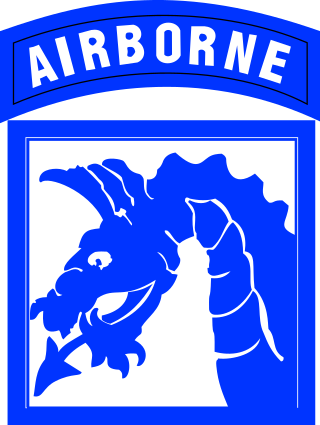
The XVIII Airborne Corps is a corps of the United States Army that has been in existence since 1942 and saw extensive service during World War II. The corps is designed for rapid deployment anywhere in the world and is referred to as "America's Contingency Corps." Its headquarters are at Fort Liberty, North Carolina.

Lieutenant General William Pelham Yarborough was a senior United States Army officer. Yarborough designed the U.S. Army's parachutist badge, paratrooper or 'jump' boots, and the airborne jump uniform. He is known as the "Father of the Modern Green Berets." He was descended from the Yorkshire House of Yarborough. Yarborough was a distant cousin to such British noble figures as the Baron Deramore, Lord Alvingham, the Duke of Buccleugh and the Marquess of Bath.
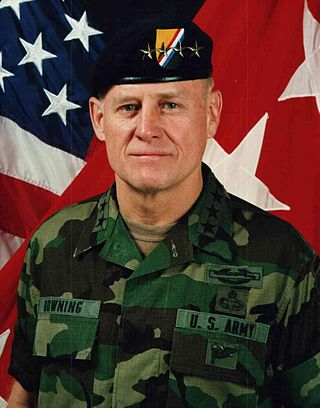
Wayne Allan Downing was a four-star United States Army general born in Peoria, Illinois. He graduated from the United States Military Academy with a Bachelor of Science degree in 1962 and held a Master of Business Administration degree from Tulane University. He also served on the board of directors at a US Government focused high-tech company, Science Applications International Corporation (SAIC).

Lieutenant General Thomas R. Turner II is a retired United States Army officer, who served as the commander of the 101st Airborne Division and United States Army North, Fort Sam Houston, Texas.

William E. "Kip" Ward is a retired United States Army three-star general who served as the inaugural Commander of United States Africa Command from October 1, 2007 to March 8, 2011. During his long career in public service, he has taught international affairs and relations at West Point, US Military Academy; served as Commander of Stabilization Force, Operation Joint Forge, Sarajevo, Bosnia; was appointed the Secretary of State's Security Coordinator to the Israel - Palestinian Authority; Deputy Commander, Headquarters US European Command, Stuttgart, Germany; and many other progressively responsible assignments. He later retired and served as President and chief operating officer of the logistics, IT, and engineering business, Vectrus.

Lieutenant General Ronald Lee Burgess Jr., United States Army is a retired United States Army lieutenant general. His last military assignment was as the 17th director of the Defense Intelligence Agency and commander of the Joint Functional Component Command for Intelligence, Surveillance and Reconnaissance (JFCC-ISR). Prior to that, he was Director of the Intelligence Staff in the Office of the Director of National Intelligence.

Curtis Michael "Mike" Scaparrotti is a retired United States Army four-star general who last served as the commander of United States European Command. He concurrently served as NATO's Supreme Allied Commander Europe. Scaparrotti previously served as the director of the Joint Staff. Prior to his tour with the Joint Staff, Scaparrotti served as commander, International Security Assistance Force Joint Command and deputy commander, U.S. Forces – Afghanistan, the commanding general of I Corps and Joint Base Lewis-McChord, and the commanding general of the 82nd Airborne Division.

R. Steven Whitcomb is a retired United States Army lieutenant general. He was commissioned as a second lieutenant upon graduation from the University of Virginia in 1970. In his final assignment he served as Inspector General of the United States Army.

William Michael Steele is a retired United States Army lieutenant general who commanded major organizations including U.S. Army, Pacific, the Combined Arms Center and the 82d Airborne Division. A native of Atlanta, Georgia, he graduated from The Citadel in 1967 and earned a Master of Arts in management from Webster University in St. Louis. His military education includes the National War College.
Lieutenant General Rodrigo F. Maclang, was the 36th Vice Chief of Staff of the Armed Forces of the Philippines, the second highest position in the AFP hierarchy. Rodrigo Maclang also served as the commander of the Northern Luzon Command, 5th Infantry (STAR) Division, and 8th Infantry (Stormtroopers) Division.

Lieutenant General John F. Mulholland Jr. is a retired senior officer who served in the United States Army and is the former Associate Director for Military Affairs (ADMA) at the Central Intelligence Agency. Mulholland previously served as Deputy Commander of the United States Special Operations Command, after having previously served in the US Army's Special Forces. He commanded special operations task forces in both Operation Enduring Freedom and Operation Iraqi Freedom, earning an appointment as Deputy Commanding General of the Joint Special Operations Command and later as Commanding General, United States Army Special Operations Command at Fort Bragg.

Patrick M. Hughes is a retired United States Army officer who served as the 12th Director of the Defense Intelligence Agency (DIA). Previously, he was Director of Intelligence for the US Joint Chiefs of Staff from 1994 to 1996 and the Director of Intelligence at United States Central Command from 1992 to 1994. He was the Commanding General, United States Army Intelligence Agency, and the Assistant Deputy Chief of Staff for Intelligence, U.S. Army from 1990 until 1992. He joined the United States Department of Homeland Security in 2003 as the Assistant Secretary for Information Analysis (Intelligence), and departed from DHS and Government service in March 2005.

John Francis Campbell is a retired United States Army general who was commander of the Resolute Support Mission and United States Forces – Afghanistan. He was the 16th and last commander of the International Security Assistance Force. Prior to this, he served as the 34th Vice Chief of Staff of the United States Army. He is currently a member of the board of directors of IAP, and BAE Systems, and serves on the advisory board of Code of Support Foundation.

Michael Ferriter is a retired United States Army Lieutenant General. He served as commanding general of the United States Army Installation Management Command/U.S. Army Assistant Chief of Staff for Installation Management from 2011 until 2014. During his career he has participated in Operation Restore Hope in Somalia, and served three tours of duty in Iraq. On June 19, 2018, he was named president and CEO of the National Veterans Memorial and Museum in Columbus, Ohio.
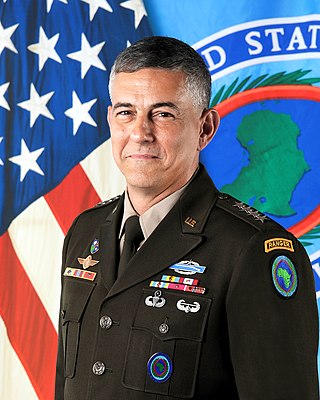
Stephen J. Townsend is a United States Army four-star general who served as Commander United States Africa Command from 26 July 2019 to 8 August 2022. He previously commanded the United States Army Training and Doctrine Command from March 2018 until June 2019 and XVIII Airborne Corps from May 2015 until January 2018.

Lieutenant General Francis M. Beaudette is a retired United States Army officer who served as the commanding general of the United States Army Special Operations Command from 2018 to 2021.
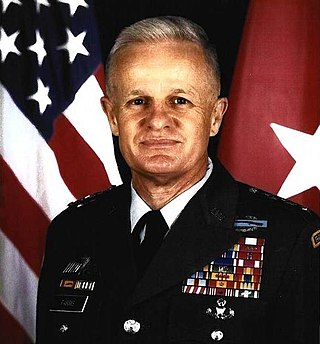
Jack Brodie Farris was a United States Army lieutenant general who commanded the military ground forces during Operation Urgent Fury, the United States invasion of Grenada in 1983; at the time of his retirement in 1991 he was deputy commander of the United States Pacific Command in Hawaii.

Major General Stephen E. Farmen was the 21st Commanding General of the U.S. Army Military Surface Deployment and Distribution Command (SDDC), the Army Service Component Command to the U.S. Transportation Command and a Major Subordinate Command to U.S. Army Materiel Command. SDDC provides deployment and distribution capabilities to meet national objectives.
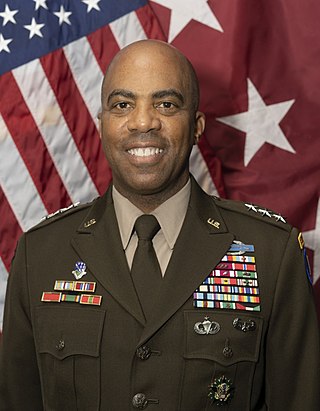
Ronald Patrick "Ron" Clark a United States Army lieutenant general who serves as the senior military assistant to the United States Secretary of Defense. He previously commanded United States Army Central from 2021 to 2022. He also served as Chief of Staff, United States Indo-Pacific Command. He previously served as the commander of the 25th Infantry Division, and, before that, as Chief of Staff, United States Army Pacific.

Richard E. Angle is a United States Army major general who currently serves as Special Assistant to the Director of the Army Staff. He previously served as deputy commander of the Joint Special Operations Command and as the commanding general of the 1st Special Forces Command (Airborne) from August 12, 2021 to June 21, 2023.



















